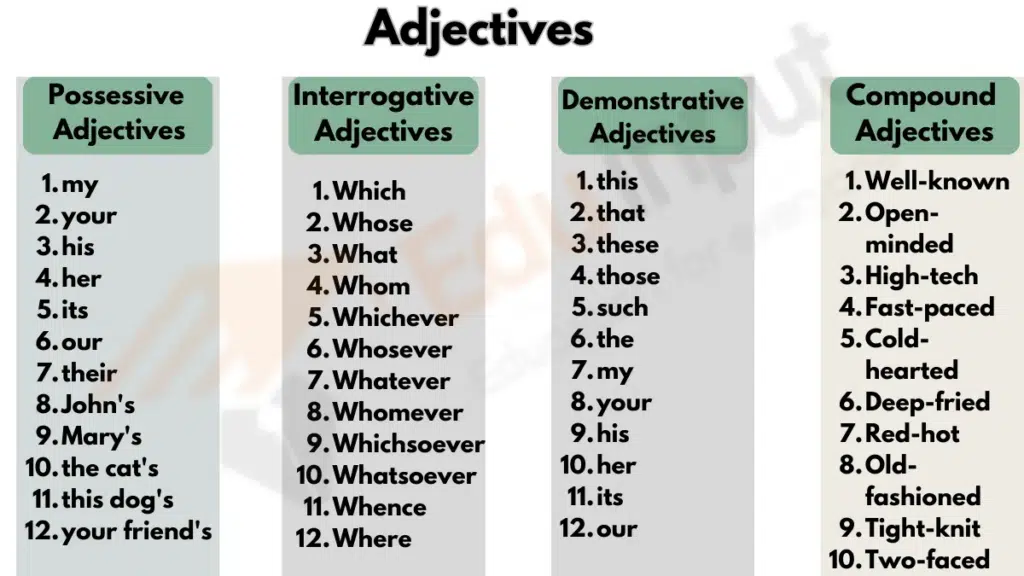Adjectives – Definition, Forms, Types, Usage and Examples
Definition of an Adjective
An adjective is a special kind of word that helps us describe a person, thing, or idea. Different dictionaries have their own ways of explaining it. For example, according to the Cambridge Dictionary, an adjective is a word that talks about a noun or pronoun.
Adjectives, like “big,” “dead,” or “financial,” give us more information about a person or thing. They often come before nouns or after linking verbs.
An adjective is a word like “big,” “red,” or “clever” that describes a person or thing. These words help us paint a picture of a big house, red wine, or a clever idea.
An adjective is a word that belongs to a special group in language. It works as a modifier for a noun, showing us a quality, quantity, or something that makes it different from other things.
Forms of Adjectives
Adjectives can help us compare things that do the same stuff! There are three ways we do this, and they’re like different levels of describing. Here they are.
- Positive or Absolute Form
- Comparative Form
- Superlative Form
1: Positive or Absolute Form
- This is the basic level. You just say how something is without comparing it to anything else.
- Example: The cat is fast. (We’re not comparing, just saying it’s fast.)
2: Comparative Form
- When you want to compare two things that do the same action, you use the comparative form.
- Example: The cheetah is faster than the cat. (Now we’re comparing their speed.)
3: Superlative Form
- This is like the top level of comparison. It’s for when you’re talking about the best or the most out of more than two things.
- Example: The cheetah is the fastest land animal. (This is saying it’s the most speedy out of all.)
Types of Adjectives

Adjectives can be categorized based on how they function in a sentence. There are various types of adjectives, including.
- Possessive Adjectives
- Interrogative Adjectives
- Demonstrative Adjectives
- Compound Adjectives
1: Possessive Adjectives
Some adjectives, like the words “my,” “your,” “his,” “her,” “their,” “its,” and “whose,” are like superhero words. They help us show or talk about who owns or has something special. For instance, “my cat,” “your book,” or “his toy.” These words are like possession superheroes.
2: Interrogative Adjectives
An adjective that asks a question while describing a noun or pronoun is called an interrogative adjective. There are only a few of them, such as “whose,” “what,” and “which.” So, when you want to know more about something, these adjectives are like your question.
3: Demonstrative Adjectives
Demonstrative adjectives are words that help point out or identify specific nouns. These adjectives include “this,” “that,” “these,” and “those.”
For example, when you say “this book” or “those shoes,” you’re using demonstrative adjectives to show which particular things you’re talking about. They’re like pointing words that help you highlight or specify certain objects.
4: Compound Adjectives
Compound adjectives are made by combining two or more words to describe a noun. These words work together to create a more specific and detailed description. Usually, compound adjectives are hyphenated.
For example, in the phrase “well-written book,” “well-written” is a compound adjective because it combines “well” and “written” to describe the noun “book.” These adjectives help provide more precise and nuanced information about the nouns they modify.
How to Use Adjectives in Sentences?
Adjectives have the power to enhance your writing and speech, adding vivid details and creating a more engaging experience for your readers or listeners. However, using too many adjectives can make your expression unclear and lead to misunderstandings. It’s essential to master the skill of knowing when, where, and how to use adjectives.
In effective writing, clarity and precision are crucial. Instead of piling up numerous adjectives, consider finding a single word that precisely conveys your intended meaning. For instance, words like “quick,” “swift,” “hasty,” and “fleet” all convey the idea of being ‘very fast.’ Similarly, various words such as “contented,” “cheerful,” “merry,” “joyful,” “ecstatic,” and “delighted” represent different degrees of happiness.
Another important aspect to be aware of is the order in which you place adjectives when using two or more to describe the same subject or object. Understanding the proper order of adjectives can further refine your expression and contribute to effective communication.
Examples of Adjectives
Descriptive Adjectives
- The sunny day brightened my mood.
- She wore a colorful dress to the party.
Quantitative Adjectives
- There were several options to choose from.
- He caught many fish during the trip.
Demonstrative Adjectives
- I’ll take this book, please.
- Look at those beautiful flowers.
Possessive Adjectives
- Her cat is playful.
- Our house is cozy.
Interrogative Adjectives
- Which movie do you want to watch?
- Whose bag is this?
Indefinite Adjectives
- I need some help with this task.
- There are several ways to solve the problem.
Numeral Adjectives
- He has five apples in his bag.
- It’s the second chapter of the book.
Exclamatory Adjectives
- What a beautiful sunset!
- That was such an amazing performance!



Leave a Reply